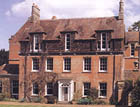What Price the Coleridge Legacy?
A unique opportunity has arisen to purchase this remarkable family’s house and its contents


How do you value a house whose architecture, contents and history represent one family?s remarkable contribution to the nation?s heritage? £3 million? £5 million? £10 million? That was the dilemma facing Lord Coleridge, the trustees of the family estate, and selling agents Knight Frank (01392 423111) when the ?traumatic? decision was taken to sell the Chanter?s House at Ottery St Mary, Devon seat of the Coleridge family for more than 200 years. So, unusually, instead of quoting a guide price, the vendors are inviting ?expressions of interest? from potential purchasers by Thursday, June 22.
The Coleridges have always lived in Devon, but the family moved to Ottery St Mary when John Coleridge, the gifted son of a Crediton weaver, became head-master of the Kings School and settled there in 1760, with his ?tribe? of four daughters and eight sons. Immense intellectual energy, athletic ability and good looks took successive generations of Coleridge men to the top of every profession they chose to enter, from the army and the navy to the law. But all were outshone by John Coleridge?s youngest son, the romantic poet Samuel Taylor Coleridge, born in 1772.
The family?s links with The Chanter?s House date from 1796, when Samuel?s second-eldest brother James, a successful career soldier who married a local heiress, bought one of Ottery St Mary?s grandest houses, thereby becoming, as Samuel slyly observed, ?a respectable man?. Built in the 1340s as a chantry, the house was the largest of a ?close? of buildings grouped around the great 14th-century church of St Mary. After the Reformation, the house passed to the Duke family, and it was from there, in 1645, that Sir Thomas Fairfax and Oliver Cromwell directed the New Model Army?s Civil War operations in the West Country (see panel above).
In 1838, the Chanter?s House passed to James Coleridge?s second son, Sir John Taylor Coleridge,a High Court judge. He and his son, John Duke Coleridge together planned the first modest extension, adding a new service range, a coach house and stables, and rebuilding the drawing room; the original 30 acres of grounds were also extended and landscaped. John Duke Coleridge was a brilliantly successful barrister, renowned for his audacity in calling the Prince of Wales to give evidence in the royal baccarat scandal case, and for his epic 26-day address to the jury which destroyed Arthur Orton?s fraudulent claim to the Tichborne baronetcy in 1872. The following year, he was made a judge and a peer, and, in 1880, Lord Chief Justice of England.
John Duke Coleridge never lost sight of his Devon roots and decided to create a country seat by rebuilding the family home which he inherited in 1876. He commissioned the architect William Butterfield to create a Victorian country mansion around the kernel of the original chantry building. The 1840s service wing was replaced with extensive new stables and service quarters, the entrance moved to the east, and an extra storey added to the old south-facing main façade. The entire west wing was taken up by a huge library 90ft long, 33ft wide and 40ft high built to accommodate Lord Coleridge?s collection of 24,000 books, and said to be ?the largest such room of any house west of Salisbury?. The cost of the alterations was a substantial £16,724 17s 9d.
The present Lord Coleridge, the 6th baron, is the seventh eldest son to have been born at the Chanter?s House, from where successive generations have gone off to make their fortune, before returning to take on the maintenance of the house, listed Grade II*, with its grand historic main rooms, 18 bedrooms, five bathrooms, and 30 acres of gardens, grounds and woodland. In recent years, the house has been run on a semi-commercial basis, as a venue for weddings, film-shoots and other functions, but Lord Coleridge?s heir is reluctant to take it on, hence the decision to sell.
For Lord Coleridge, the ideal outcome would be a sale to a buyer who would keep house and contents intact; failing that, the unique collection of pictures, books and family memorabilia will be auctioned by Sotheby?s at a later date.
Sign up for the Country Life Newsletter
Exquisite houses, the beauty of Nature, and how to get the most from your life, straight to your inbox.
This article first appeared in Country Life magazine on May 25, 2006.
Country Life is unlike any other magazine: the only glossy weekly on the newsstand and the only magazine that has been guest-edited by HRH The King not once, but twice. It is a celebration of modern rural life and all its diverse joys and pleasures — that was first published in Queen Victoria's Diamond Jubilee year. Our eclectic mixture of witty and informative content — from the most up-to-date property news and commentary and a coveted glimpse inside some of the UK's best houses and gardens, to gardening, the arts and interior design, written by experts in their field — still cannot be found in print or online, anywhere else.
-
 Two quick and easy seasonal asparagus recipes to try this Easter Weekend
Two quick and easy seasonal asparagus recipes to try this Easter WeekendAsparagus has royal roots — it was once a favourite of Madame de Pompadour.
By Melanie Johnson
-
 Sip tea and laugh at your neighbours in this seaside Norfolk home with a watchtower
Sip tea and laugh at your neighbours in this seaside Norfolk home with a watchtowerOn Cliff Hill in Gorleston, one home is taller than all the others. It could be yours.
By James Fisher